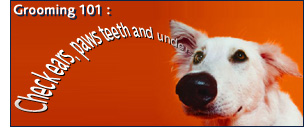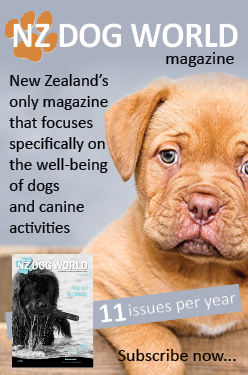Caring For Your Dog - Grooming
 Grooming 101
Grooming 101
Grooming a dog accomplishes much more than just making its coat look nice and shiny. It will provide an opportunity to spend some "quality time" with the dog, combing, brushing, bathing and generally bonding with it.
Check the dog closely for any problems while grooming. Move the hair aside and examine the skin closely for signs of fleas or skin irritations. Look for any unusual problems with the coat such as mats, tangles, dandruff, etc. Carefully remove all mats and tangles while grooming.
Learn where the dog likes to be combed and brushed and where it does not. All dogs have sensitive areas that need grooming a little more gently and carefully. By paying special attention to these areas, it will help make the dog more comfortable while being groomed and it will not resist future grooming sessions.
Let your dog sniff the brush and comb before beginning grooming, and then talk to the dog in a reassuring tone while grooming. If the grooming procedure is made comfortable for the dog, it will begin to look forward to regular grooming sessions.
Health
Regular grooming is essential to a dog's health and well being. Regular combing and brushing with will keep the coat clean and healthy. It will stimulate the skin, and allow the natural oils to circulate to the coat. It will also provide an opportunity to check for potentially serious problems. Check areas for hair loss, inflammation, unusual tenderness or lumps under the skin. Constant scratching in a particular area may also be an indication of a problem. Check with a veterinarian about any unusual problems found.
Puppies
Like children, puppies have short attention spans. They will require some special attention. Select a time when the puppy is less energetic. Begin with short grooming sessions, five minutes or so. Constantly talk to the puppy in a gentle, reassuring tone while grooming to make it feel comfortable. Be sure to check its ears, paws, teeth, and underside during the grooming procedure. This will make it accustomed to being handled and examined. Eventually, it will be quite comfortable being groomed, and will look forward to these sessions.
Frequency
It is important to establish and stick to a regular schedule of grooming sessions. Schedule these at a convenient time. A good time to do this is after returning from a walk. Select a time when there will be no interruptions and there is ample time to do a proper grooming. Daily grooming is often required for longhaired dogs, while shorthaired breeds may require grooming only twice a week.
Nail Trimming
Regular nail trimming is important to the dog's health and well-being. Never use ordinary scissors to trim a dog's nails. Use nail clippers that are specially designed for dogs. Hold the dog's paw firmly, and cut off the tip of the nail with a single stroke. Be very careful to stop short of the quick, the blood vessel inside the nail. The quick is easily seen in dogs with white nails. More care should be taken with dogs with black nails. Cutting the nails right after bathing will make the quick more visible.
Professional grooming
Some breeds require more commitment to grooming than others. A professional groomer can help with this. A discussion with the groomer will have the dog looking just the way the owner wants, whether in a show clip, or an easy maintenance pet clip. Even with professional grooming though, some grooming will be necessary in the home.







